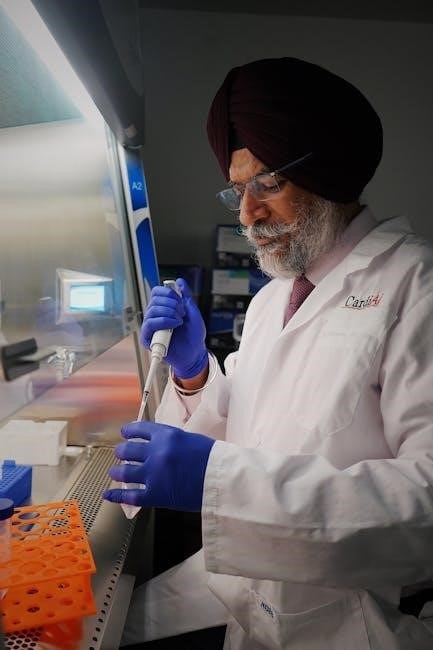Genetics is the scientific study of heredity, genes, and variation. It explores how traits are inherited and how genes influence life processes. Understanding genetics helps us uncover the molecular mechanisms behind life, disease, and evolution, making it a cornerstone of modern biology.
1.1 Key Concepts and Terminology in Genetics
Genetics involves understanding key terms like genes, DNA, chromosomes, and traits. Genes are units of heredity carrying genetic information. DNA is the molecule containing genetic instructions. Chromosomes are structures holding genes. Traits are characteristics passed through generations. Inheritance patterns, such as dominant and recessive genes, explain how traits are inherited. Genetic disorders arise from mutations or inherited defects. These concepts form the foundation for studying genetics and its applications in health and biology.
1.2 Importance of Studying Genetics
Studying genetics provides insights into heredity, disease mechanisms, and evolutionary processes. It aids in diagnosing genetic disorders, developing personalized treatments, and advancing agricultural practices. Genetics also enhances understanding of human diversity and environmental interactions. By exploring genetic principles, researchers can address health challenges, improve crop yields, and conserve species. This knowledge is vital for medical advancements, ethical considerations, and broader biological understanding, making genetics a cornerstone of modern science and its applications.
DNA Structure and Function
DNA is a double helix made of nucleotides, storing genetic information. Genes, sequences of DNA, code for proteins essential for life. DNA replicates and passes traits.
2.1 The Double Helix Model of DNA
The double helix model, proposed by Watson and Crick, describes DNA as two complementary strands twisted together. Each strand consists of a sugar-phosphate backbone with nitrogenous bases—adenine, thymine, cytosine, and guanine—projecting inward. Adenine pairs with thymine, and cytosine with guanine, forming a spiral staircase. This structure allows DNA to replicate and store genetic information efficiently, making it a fundamental discovery in genetics and molecular biology.
2.2 DNA Replication and Transcription
DNA replication is a semi-conservative process where the double helix unwinds, and each strand serves as a template for a new complementary strand. Helicase separates the strands, while DNA polymerase synthesizes the new DNA. Transcription involves RNA polymerase creating mRNA from a DNA template, enabling gene expression. These processes are essential for genetic inheritance and the transmission of biological information, forming the basis of life and cellular function.

Mendelian Inheritance
Mendelian inheritance describes how genes are passed from parents to offspring, following predictable patterns. It forms the foundation of genetics, explaining trait transmission through generations.
3.1 Laws of Inheritance
The laws of inheritance, discovered by Gregor Mendel, are fundamental principles that explain how genes are transmitted across generations. The Law of Segregation states that gene pairs separate during gamete formation. The Law of Dominance explains how one allele can mask another. The Law of Independent Assortment describes how genes for different traits are inherited independently. These laws provide the foundation for understanding genetic inheritance patterns and predicting trait probabilities in offspring.
3.2 Punnett Squares and Probability
Punnett squares are tools used to predict the probability of trait inheritance. By crossing alleles from each parent, they illustrate all possible genotypic combinations. Each square divides into four quadrants representing outcomes, with probabilities calculated as fractions. This method helps determine the likelihood of dominant or recessive traits in offspring, aiding in genetic counseling and experimental design. Understanding Punnett squares is essential for predicting hereditary patterns and genetic outcomes.

Genetic Disorders
Genetic disorders result from mutations or inherited traits, affecting various bodily systems and ranging in severity from mild to life-threatening conditions.
4.1 Types of Genetic Disorders
Genetic disorders are categorized into single-gene, chromosomal, and multifactorial types. Single-gene disorders, like cystic fibrosis, result from mutations in one gene. Chromosomal disorders, such as Down syndrome, involve structural or numerical abnormalities. Multifactorial disorders, like heart disease, arise from gene-environment interactions. Understanding these types is crucial for diagnosis, management, and personalized treatment approaches in modern medicine.
4.2 Diagnosis and Management of Genetic Disorders
Diagnosing genetic disorders involves genetic testing, prenatal screening, and physical examinations. Techniques like karyotyping and DNA sequencing identify chromosomal or gene mutations. Management strategies include gene therapy, lifestyle modifications, and supportive care. Early intervention and personalized treatments improve quality of life. Advances in CRISPR technology offer promising therapeutic options. Genetic counseling is essential for families to understand risks and make informed decisions, ensuring tailored approaches for each condition.

Modern Genetic Techniques
Modern genetic techniques include CRISPR, gene editing, and genetic testing. These tools enable precise DNA modifications and personalized medicine, revolutionizing research and treatment of genetic diseases.
5.1 CRISPR and Gene Editing
CRISPR-Cas9 is a revolutionary gene-editing tool enabling precise DNA modifications. It allows scientists to target specific genes, correcting inherited disorders or introducing desired traits. This technology has transformed research and medicine, offering potential cures for genetic diseases like sickle cell anemia and cystic fibrosis. However, ethical concerns arise regarding unintended consequences and the possibility of “designer babies.” Proper regulation and ethical frameworks are essential to ensure responsible use of this powerful technology.
5.2 Genetic Testing and Counseling
Genetic testing identifies DNA variations linked to diseases or traits, providing insights into inherited risks. Counseling helps individuals understand test results, make informed decisions, and cope with implications. It addresses ethical, legal, and psychological aspects, ensuring patients are well-informed about options like family planning or preventive care. This process bridges science and empathy, empowering individuals to navigate genetic information responsibly and make personalized health choices.

Ethical Considerations in Genetics
Genetic advancements raise ethical concerns, including privacy issues, equity in access to genetic technologies, and the moral implications of altering human DNA. Society must balance scientific progress with ethical responsibilities to ensure genetic knowledge is used for the greater good while respecting individual rights and cultural values.
6.1 Privacy Issues in Genetic Testing
Genetic testing raises significant privacy concerns, as it reveals sensitive personal information. There is a risk of unauthorized access to genetic data, potentially leading to discrimination in employment, insurance, or other areas. Ensuring the confidentiality of genetic information is crucial to protect individuals’ rights and prevent misuse. Strong ethical frameworks and regulations are necessary to safeguard privacy while advancing genetic research and testing.
6.2 Ethical Implications of Genetic Engineering
Genetic engineering raises ethical concerns, including issues of privacy, informed consent, and the potential for unintended consequences. Manipulating DNA can lead to germline modifications, affecting future generations. There are also concerns about the possibility of genetic discrimination and inequality. Ethical debates focus on balancing medical advancements with moral boundaries, emphasizing the need for strict regulations to prevent misuse while promoting beneficial applications of genetic technologies.

Heredity and Environment Interaction
Genetics and environment interact to shape traits and health, with heredity influencing predispositions and environmental factors affecting gene expression and phenotype development.
7.1 Nature vs. Nurture Debate
The nature vs. nurture debate explores whether traits are primarily influenced by genetics or environmental factors. Recent studies suggest a dynamic interaction, with genes setting predispositions and environments shaping gene expression. This understanding is crucial for personalized medicine, as it highlights how both hereditary and external factors contribute to health and behavior, enabling tailored interventions to prevent or manage conditions effectively.
7.2 Epigenetics and Environmental Factors
Epigenetics examines how environmental factors influence gene expression without altering DNA sequences. Factors like diet, stress, and pollution can modify DNA methylation and histone structure, affecting gene activity. These changes can be heritable and impact disease susceptibility. Understanding epigenetics reveals how external conditions interact with genetic predispositions, shaping traits and health outcomes. This field highlights the dynamic interplay between genes and the environment, offering insights into personalized medicine and preventive healthcare strategies.

Applications of Genetics in Medicine
Genetics revolutionizes medicine through personalized treatments, targeted therapies, and gene editing, enabling precise disease management and innovative cures, improving patient outcomes significantly today.
8.1 Personalized Medicine and Targeted Therapies
Personalized medicine uses genetic data to tailor treatments to individual needs, improving efficacy and reducing side effects. Targeted therapies, like those for cancers with specific mutations, focus on precise molecular targets. Genetic testing identifies biomarkers, enabling customized drug therapies. For example, BRCA1/BRCA2 mutations guide breast and ovarian cancer treatments. This approach enhances patient outcomes and minimizes harm, revolutionizing healthcare by making it more precise and effective for diverse genetic profiles and conditions.
8.2 Gene Therapy and Future Prospects
Gene therapy treats genetic disorders by modifying or replacing faulty genes, offering precise solutions for inherited diseases. Current therapies successfully address conditions like severe combined immunodeficiency and certain cancers. Future advancements, such as CRISPR-Cas9, promise more efficient and targeted gene editing. Researchers are refining delivery methods and expanding applications to complex diseases. This field holds immense potential for curative treatments, transforming healthcare by addressing the root causes of genetic and acquired disorders with unprecedented accuracy and hope.

Genetics and Evolution
Genetics and evolution are deeply intertwined, as genetic variation drives evolutionary change. Natural selection acts on heritable traits, shaping species over time through genetic diversity and adaptation.
9.1 Role of Genetics in Evolutionary Processes
Genetics plays a central role in evolution by providing the raw material—genetic variation—on which natural selection acts. Mutations introduce new alleles, and genetic drift alters allele frequencies, influencing population diversity. These genetic mechanisms drive evolutionary changes, enabling species to adapt to environments and leading to the emergence of new species over time.
9.2 Phylogenetics and Evolutionary Trees
Phylogenetics studies evolutionary relationships using genetic data. Evolutionary trees, or phylogenies, visualize these relationships, showing how species diverge over time. Built from DNA or protein sequences, these trees reveal shared ancestry and trait evolution. Methods like maximum parsimony or Bayesian inference construct them. Phylogenetic trees aid in understanding biodiversity, disease spread, and evolutionary adaptation, making them essential tools in genetics, medicine, and ecology.

Agricultural Genetics
Agricultural genetics enhances crop and livestock productivity through genetic improvement. Techniques like selective breeding and GMOs increase yield, disease resistance, and nutritional value, ensuring food security and sustainability.
10.1 Genetic Improvement of Crops and Livestock
Genetic improvement of crops and livestock involves selective breeding and genetic engineering to enhance desirable traits. Traditional methods rely on natural selection and crossbreeding, while modern techniques use biotechnology to introduce specific genes. These practices aim to increase yield, disease resistance, and nutritional value, ensuring sustainable food production. Advances in agricultural genetics have revolutionized farming, addressing global food demands and environmental challenges effectively.
10.2 GMOs and Their Impact on Food Production
Genetically modified organisms (GMOs) are engineered to possess specific traits, enhancing food production. GMO crops often exhibit improved yield, pest resistance, and drought tolerance, addressing global food security challenges. While GMOs increase agricultural efficiency, concerns about safety, environmental impact, and regulatory oversight persist. Their adoption has sparked debates, balancing benefits like increased food availability against potential ecological and health risks, making GMOs a controversial yet significant factor in modern agriculture.




About the author